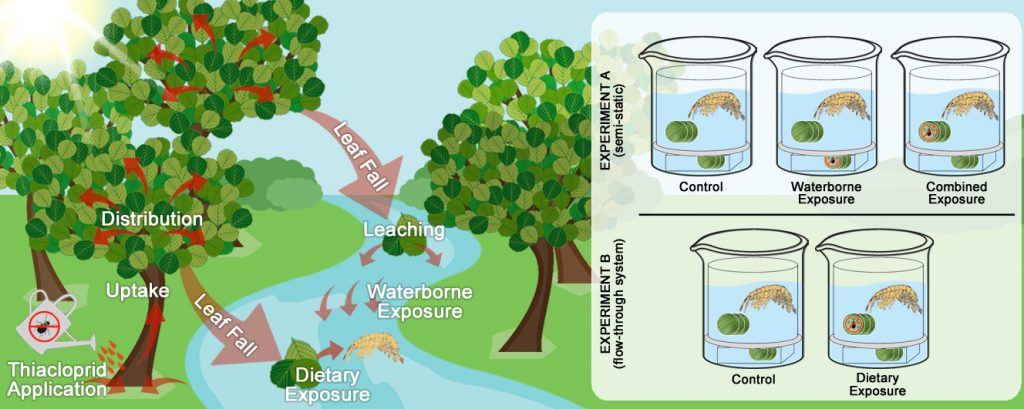In this post, we talk about our recently published paper “Relative importance of dietary uptake and waterborne exposure for a leaf-shredding amphipod exposed to thiacloprid-contaminated leaves”.
Systemic neonicotinoid insecticides are increasingly applied in forestry as protective measure against insect pests. Following their application, the insecticides are taken up and distributed in trees providing long lasting protection against root-, stem-, and leaf-feeding pests. However, contaminated leaves and needles might be released to the surrounding environment, including nearby streams, during autumn leaf fall. There, organisms that heavily rely on allochthonous organic material as a food source could be exposed to neonicotinoids when feeding on these contaminated leaves (= dietary exposure). In addition, the insecticides may be remobilized from leaves resulting in an exposure of these non-target aquatic organisms via the water phase (= waterborne exposure). However, the relative importance of these exposure pathways (i.e., dietary vs. waterborne) has not yet been disentangled. Therefore, we subjected the leaf-shredding amphipod Gammarus fossarum for 21 days either to dietary exposure, waterborne exposure or a combination of both (= combined exposure) using leaves collected from trees treated with the neonicotinoid thiacloprid.
While lethal effects were only observed when G. fossarum was simultaneously exposed via both pathways, dietary as well as waterborne exposure resulted in similar adverse sublethal effects in gammarids’ leaf consumption and lipid content. However, sublethal effects induced by the combined exposure exceeded those observed for each of the exposure pathways individually. Moreover, thiacloprid residues detected in gammarids suggest that dietary exposure may also be relevant for predators preying on Gammarus. Hence, neglecting dietary uptake might underestimate the environmental risk systemic insecticides pose for ecosystem integrity.
The paper was authored by Dominic Englert, Jochen P. Zubrod, Sebastian Pietz, Sonja Stefani, Martin Krauss, Ralf Schulz and Mirco Bundschuh and published in Scientific Reports. The paper is freely available via the journal’s webpage.

